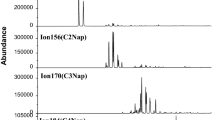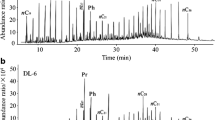Abstract
The composition and physical properties of spilled oil have great changes during the seriously weathering process. It brings great difficulties to the source identification of oil spill. So the stable and trustworthy diagnostic ratios (DRs) for accurate identification of severely weathered spilled oils are very important. The explosion of Sinopec pipeline happened on November 22, 2013 at Qingdao, China. Local beaches at Jiaozhou Bay were polluted by spilled oils. We have collected original spilled oil samples from an area free from human interference near the oil leakage point after the accident. Synchronized with actual beach weathering, laboratory experiments were conducted to simulate oil weathering for 360 days by using the collected original spilled oil samples. Based on t test and the repeatability limit method, 50 diagnostic ratios (DRs) of adamantanes were screened. Four DRs, namely 1,3-dimethyladamantane/total dimethyladamantane, 1-methyladamantane/(1-methyladamantane + 1,3-dimethyladamantane), dialkyl diamantane/total diamantane, and diamantane/(diamantane + dialkyl diamantane), have maintained remarkable stability during the simulated weathering experiments and field weathering process. These stable ratios can retain the characteristics of oil source during weathering. They are very beneficial to improve the accuracy of identifying the source of severely weathered oil and can be used as an effective supplement to existing index system for source identification.






Similar content being viewed by others

References
Bayona, J., Domínguez, C., & Albaigés, J. (2015). Analytical developments for oil spill fingerprinting. Trends in Environmental Analytical Chemistry, 5, 26–34.
Brakstad, O., Daling, P., Faksness, L., Vang, S., Syslak, L., & Leirvik, F. (2014). Depletion and biodegradation of hydrocarbons in dispersions and emulsions of the macondo 252 oil generated in an oil-on-seawater mesocosm flume basin. Marine Pollution Bulletin, 84, 125–134.
Burgherr, P. (2007). In-depth analysis of accidental oil spills from tankers in the context of global spill trends from all sources. Journal of Hazardous Materials, 140, 245–256.
Chen, J., Fu, J., Sheng, G., Liu, D., & Zhang, J. (1996). Diamondoid hydrocarbon ratios: novel maturity indices for highly mature crude oils. Organic Geochemistry, 25, 179–190.
Daling, P., Faksness, L., Hansen, A., Kienhuis, P., & Duus, R. (2014). Improved methodology for oil spill identification of waterborne petroleum and petroleum products. In Proceedings of 4th international conference on oils and environment.
Daling, P., Faksness, L., Hansen, A., & Stout, S. (2002). Improved and standardized methodology for oil spill fingerprinting. Environmental Forensics, 3, 263–278.
Doval, M., Moroño, A., Pazos, Y., Lopez, A., Madriñán, M., & Cabanas, J. (2006). Monitoring dissolved aromatic hydrocarbon in rias baixas embayments (NW spain) after prestige oil spills: relationship with hydrography. Estuarine, Coastal and Shelf Science, 67, 205–218.
Faksness, L. G., Daling, P. S., Hansen, A. B., Kienhuis, P., & Duus, R. (2005). New guidelines for oil spill identification of waterborne petroleum and petroleum products. In Arctic and Marine Oil Spill Program Technical Seminar.
Fang, C., Xiong, Y., Li, Y., Chen, Y., Liu, J., Zhang, H., et al. (2013). The origin and evolution of adamantanes and diamantanes in petroleum. Geochimica et Cosmochimica Acta, 120, 109–120.
Fingas, M. (1996). The evaporation of oil spills: prediction of equations using distillation data. Spill Science and Technology Bulletin, 3, 191–192.
Fitzgerald, T., & Gohlke, J. (2014). Contaminant levels in gulf of mexico reef fish after the deepwater horizon oil spill as measured by a fishermen-led testing program. Environmental Science and Technology, 48, 1993–2000.
Giruts, M., Derbetova, N., Erdnieva, O., Stokolos, O., Koshelev, V., & Gordadze, G. (2013). Identification of tetramantanes in crude oils. Petroleum Chemistry, 53, 285–287.
Gonnelli, M., Galletti, Y., Marchetti, E., Mercadante, L., Brogi, S. R., Ribotti, A., et al. (2016). Dissolved organic matter dynamics in surface waters affected by oil spill pollution: results from the serious game exercise. Deep-Sea Research Part II Topical Studies in Oceanography, 133, 88–99.
Grice, K., Alexander, R., & Kagi, R. (2000). Diamondoid hydrocarbon ratios as indicators of biodegradation in Australian crude oils. Organic Geochemistry, 31, 67–73.
Guo, X., He, S., & Cheng, H. (2007). Discussion and application of the maturity indicators of methyl double diamantane hydrocarbons. Geological Science & Technology Information (China), 26(1), 71–76.
Han, B., Chen, J., Zheng, L., Zhou, T., Li, J., & Wang, X. (2015). Development of an impurity profiling method for source identification of spilled benzene series compounds by gas chromatography with mass spectrometry: Toluene as a case study. Journal of Separation Science, 38, 3198–3204.
Harriman, B., Zito, P., Podgorski, D., Tarr, M. A., & Suflita, J. (2017). Impact of photooxidation and biodegradation on the fate of oil spilled during the deepwater horizon incident: Advanced stages of weathering. Environmental Science and Technology, 51, 7412–7421.
Hou, X., Hodges, B., Feng, D., & Liu, Q. (2017). Uncertainty quantification and reliability assessment in operational oil spill forecast modeling system. Marine Pollution Bulletin, 116, 420.
Lee, C., Lee, J., Sung, C., Moon, S., Kang, S., Lee, J., et al. (2013). Monitoring toxicity of polycyclic aromatic hydrocarbons in intertidal sediments for five years after the Hebei Spirit oil spill in Taean, Republic of Korea. Marine Pollution Bulletin, 76, 241–249.
Lehr, W. J., & Simecek-Beatty, D. (2000). The relation of langmuir circulation processes to the standard oil spill spreading, dispersion, and transport algorithms. Spill Science and Technology Bulletin, 6, 247–253.
Li, J., Philp, P., & Cui, M. (2000). Methyl diamantane index (mdi) as a maturity parameter for lower palaeozoic carbonate rocks at high maturity and overmaturity. Organic Geochemistry, 31, 267–272.
Morales-Caselles, C., Kalman, J., Micaelo, C., Ferreira, A., Vale, C., & Riba, I. (2008). Sediment contamination, bioavailability and toxicity of sediments affected by an acute oil spill: Four years after the sinking of the tanker prestige (2002). Chemosphere, 71, 1207–1213.
Nelson, R., Kile, B., Plata, D., Sylva, S., Li, X., & Reddy, C. (2006). Tracking the weathering of an oil spill with comprehensive two-dimensional gas chromatography. Environmental Forensics, 7, 33–44.
Page, D., Foster, J., Fickett, P., & Gilfillan, E. (1988). Identification of petroleum sources in an area impacted by the amoco cadiz, oil spill. Marine Pollution Bulletin, 19, 107–115.
Riehm, D., Rokke, D., Paul, P., Lee, H., Vizanko, B., & Mccormick, A. (2017). Dispersion of oil into water using lecithin-tween 80 blends: The role of spontaneous emulsification. Journal of Colloid and Interface Science, 487, 52–59.
Sidiras, D., Batzias, F., Konstantinou, I., & Tsapatsis, M. (2014). Simulation of autohydrolysis effect on adsorptivity of wheat st raw in the case of oil spill cleaning. Chemical Engineering Research and Design, 92, 1781–1791.
Sun, P., Bao, M., Li, G., Wang, X., Zhao, Y., Zhou, Q., et al. (2009a). Fingerprinting and source identification of an oil spill in china bohai sea by gas chromatography-flame ionization detection and gas chromatography-mass spectrometry coupled with multi-statistical analyses. Journal of Chromatography A, 1216, 830–836.
Sun, P., Gao, Z., & Cui, W. (2007). Development and application of oil spill identification techniques (China) (pp. 105–114). Beijing: Ocean Publishing House.
Sun, P., Gao, Z., Zhao, Y., Wang, X., Cao, X., & Li, G. (2009b). Evaluation of the oil spill accident in Bohai sea, China. Environmental Forensics, 10, 308–316.
Wang, Z., & Fingas, M. (2003). Development of oil hydrocarbon fingerprinting and identification techniques. Marine Pollution Bulletin, 47, 423–452.
Wang, Z., Fingas, M., & Page, D. (1999). Oil spill identification. Journal of Chromatography A, 843, 369–411.
Wang, Z., Li, K., Fingas, M., Sigouin, L., & Ménard, L. (2002). Characterization and source identification of hydrocarbons in water samples using multiple analytical techniques. Journal of Chromatography A, 971, 173–184.
Wang, Q., Wen, M., Yan, Z., Sun, B., Liu, H., & Ying, Y. (2015). Repeatability limit analysis of crude oil fingerprints affected by oil spill dispersant. Environmental Science & Technology (China), 38, 74–77.
Wang, Z., Yang, C., Yang, Z., Brown, C., Hollebone, B. P., & Stout, S. A. (2016). Petroleum biomarker fingerprinting for oil spill characterization and source identification. Standard Handbook Oil Spill Environmental Forensics, 7, 131–254.
Yim, U., Khim, J., Kim, M., Jung, J., & Shim, W. (2017). Environmental impacts and recovery after the Hebei Spirit oil spill in Korea. Archives of Environmental Contamination and Toxicology, 73, 47–54.
Zheng, L., Cao, J., & Xue, J. (1998). A new index for the maturity of crude oil and hydrocarbon source rock: methyl-diamantane index. Experimental Petroleum Geology (China), 20, 411–416.
Acknowledgements
This work was financially supported by Basic Scientific Fund for National Public Research Institutes of China (2017Q05) and China-ASEAN Maritime Cooperation Fund: East Asia Marine Cooperation Platform, the project of the National Key Research and Development Program (2016YFC0503602).
Author information
Authors and Affiliations
Corresponding author
Rights and permissions
About this article
Cite this article
Han, B., Zheng, L., Li, Q. et al. Evaluation of the diagnostic ratios of adamantanes for identifying seriously weathered spilled oils from simulated experiment and actual oil spills. Environ Geochem Health 41, 817–828 (2019). https://doi.org/10.1007/s10653-018-0177-x
Received:
Accepted:
Published:
Issue Date:
DOI: https://doi.org/10.1007/s10653-018-0177-x



